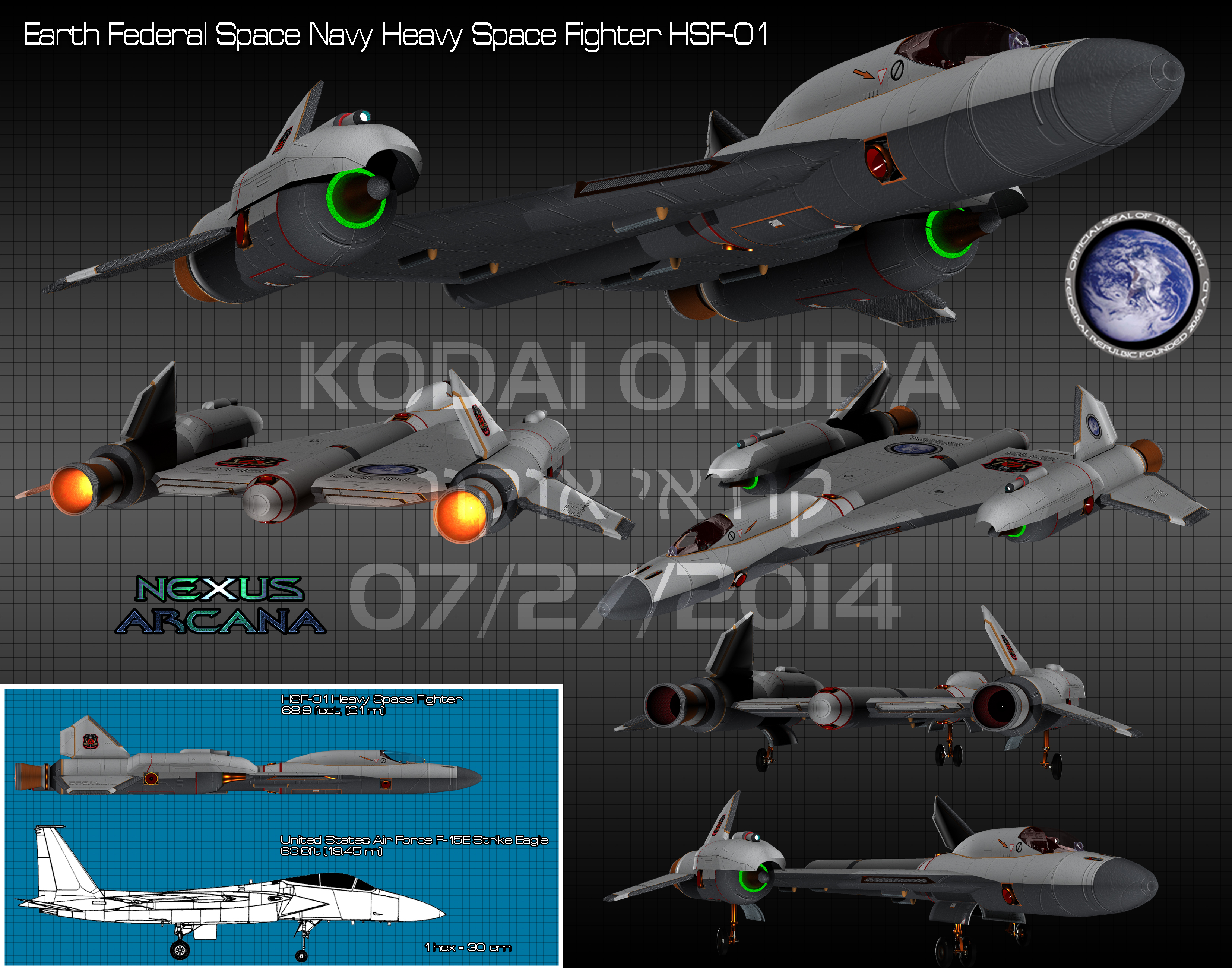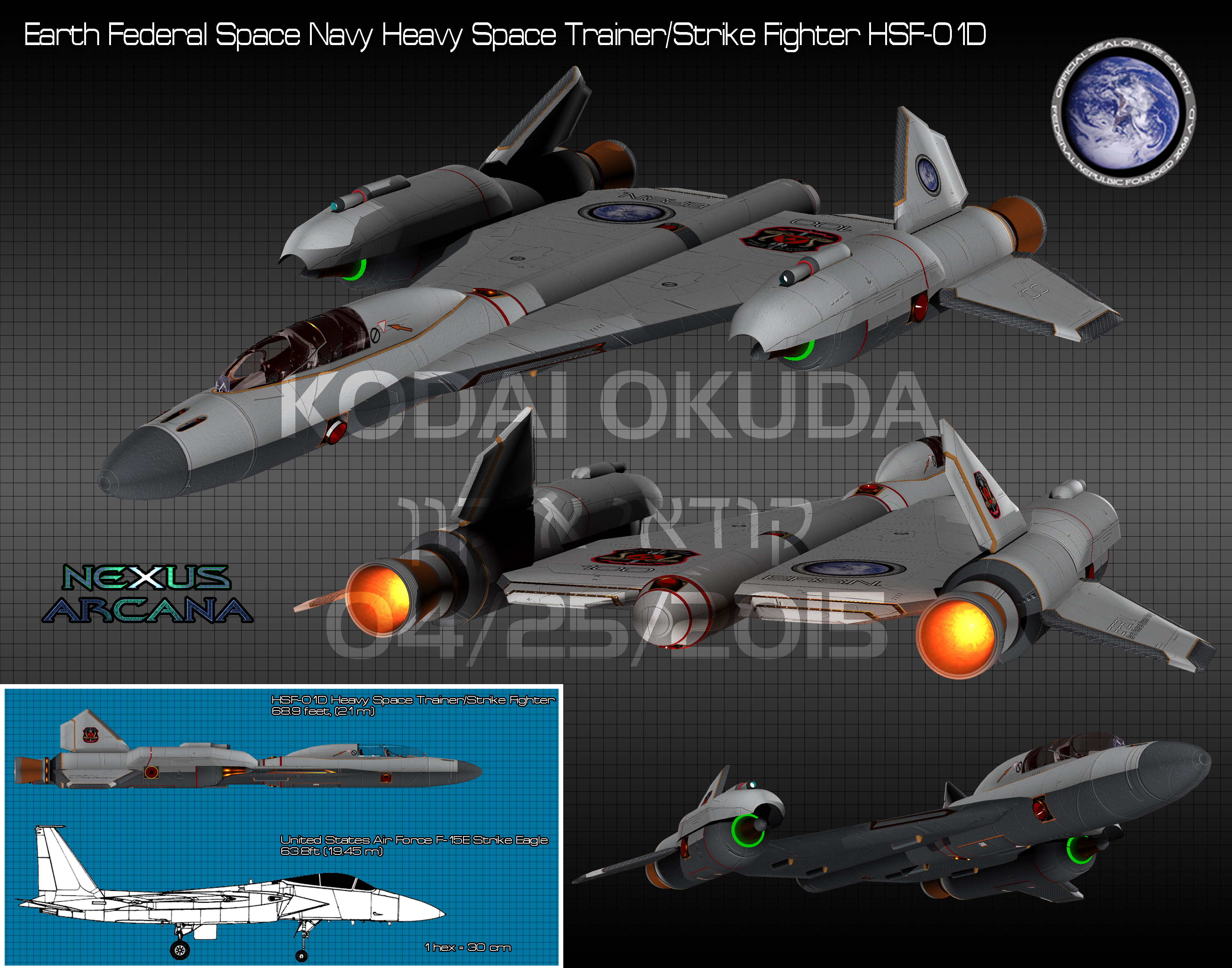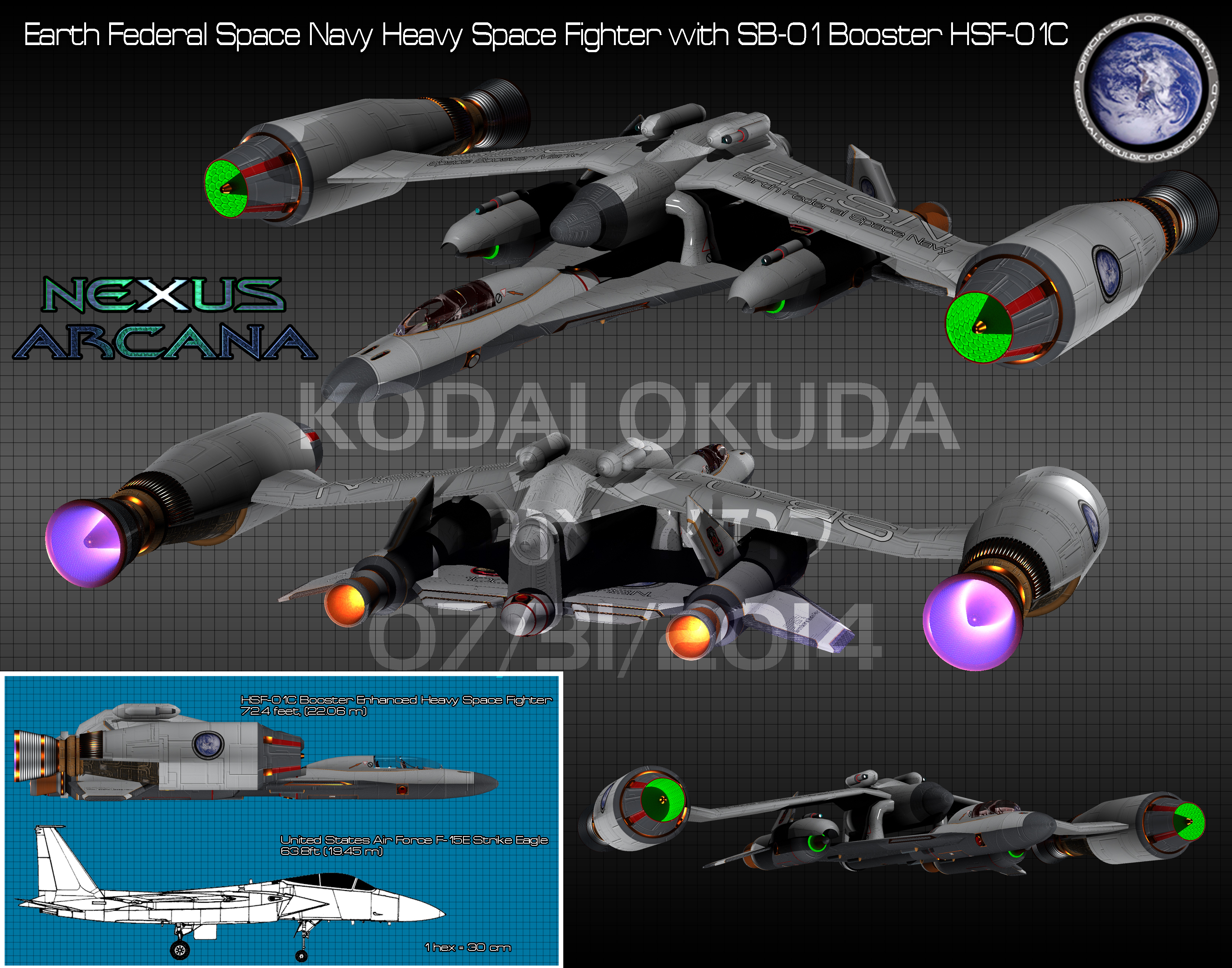 |
||
 |
||

HSF-01
GOVERNMENT: Earth Federal Republic
TYPE: Heavy Space Superiority Fighter
MODELS: MacDonald-Doogrim HSF-01 "Meteor"
DATE INTRODUCED: 2170 A.D. (HSF-01)
LENGTH: 68.9 feet (21 meters)
WIDTH: 50.8 feet (15.5 meters)
HEIGHT: 11.2 feet (3.4 meters)
MATERIAL: Composite-Alloy (all models)
POWER PLANT: Federal Energy FEFR-350
OUTPUT: 350 megawatts
ARMOR TYPE: Crystal Composite (all models)
ARMOR THICKNESS: 2 inches
DISPLACEMENT: 50 tons
CREW: 1 Pilot
PROPULSION
PRIMARY:
2x Rocketdyne FT-25 fusion thrusters
SPEED: 76,000 mph each (152,000 mph total)
WEAPONS:
PRIMARY (OFFENSIVE):
Lunar Dynamics LD-PLC-10 10-megawatt pulse laser cannons; Effective Range: 100 miles; Payload: unlimited with 100-megawatt nuclear battery clutch; ROF: bursts of 2, 5, or 10 blasts per cannon with a cyclic rate of 60 blasts each per minute or 120 blasts per minute total from both cannons.
SECONDARY (OFFENSIVE):
The fighter was able to hold up to 20 tons of bombs and missiles externally. There were three hard points under each wing (1 forward next to the aft section of the cockpit, and two side by side under the wing next to the inside of the engine nacelle) and one hard point on the centerline of the fuselage, for a total of 7 hard points. The standard outside ordinance payload normally consisted of 12, SST-1M, 1000-pound short-range space torpedoes (2 torpedoes on each hard point except the center hard point, which was left empty). After 2173 AD, the payload became 6, MST-1M 1000lb medium-range space torpedoes (one on each hard point except the center) and a pair of Bohing/MMI M230-AC-GP gunpods mounted side by side, facing forward, on the center hard point. This configuration was used up until 2225 AD, when the HSF-01 was retired from service.
ELECTRONICS:
1x Laser Communications array with a 10 AU range.
1x Passive EMS array with a range of 100,000 miles.
1x Active EMS array with a range of 1000 miles.
1x Gravitational Control/Antigravity unit Effect: provides artificial lift,g-force compensation and enhanced maneuverability.
DEFENSE SYSTEMS:
6x Militia Military Industries ND-5 5-megawatt nuclear dampener generators; RANGE: 2540 feet; Effect: Random due to numerous variables. In general, the nuclear dampeners provided moderate to considerable resistance to energy weapons and were able to cause missile warheads to either explode or go inert within its area of effect.
Description/Overview:
(HSF-01)
The HSF-01 was the first craft built using TerraTech (Terran Technology). With elements of both the alien (Prodono) and Earth technologies incorporated into it, the HSF-01 was the most advanced spacecraft of its time. The HSF-01 was designed to replace the Kentucky class of assault shuttles. However, it did not; instead, it was used in addition to the Kentucky class, usually protecting Ogre class troopships. Its primary role as a space fighter was the defense of spacecraft within the EFR fleet. The secondary role of this space fighter was as an interceptor. The HSF-01 was often used to intercept and destroy enemy escort ships and cruisers.
The HSF-01 was used up until the end of the 2nd Interplanetary War (2194 AD). During the 1st and 2nd Interplanetary Wars, the HSF-01 performed well against the UNSC, Ceres, and USSR mobile weapons. However, by the end of the 2nd Interplanetary War, the HSF-01 was obviously too venerable and obsolete to remain in service with the EFSN. The newer mobile weapons and transformable fighters were far superior to the HSF-01, and all but 23,000 were destroyed during the 2nd Interplanetary War. These remaining craft found their way into colonial defense forces after the Planetary Alliance sold them off in 2225 AD.
The only design variant of this craft was the HSF-01D, which was the two-seat trainer version. Other than the twin-seat cockpit, the craft was identical to the standard HSF-01.

HSF-01D
GOVERNMENT: Earth Federal Republic
TYPE: Heavy Space Superiority Strike Fighter/Trainer
MODELS: Lokheed HSF-01D "Double"
DATE INTRODUCED: 2171 A.D. (HSF-01D)
LENGTH: 68.9 feet (21 meters)
WIDTH: 50.8 feet (15.5 meters)
HEIGHT: 11.2 feet (3.4 meters)
MATERIAL:
Composite-Alloy (fighter)
Crystal Composite (booster)
POWER PLANT:
Federal Energy FEFR-350 (fighter)
Federal Energy FEFR-175 (booster reactor)
OUTPUT:
350 megawatts (fighter)
175 megawatts (boosters only)
ARMOR TYPE:
Crystal Composite
ARMOR THICKNESS:
2 inches (fighter)
2 inches (booster)
DISPLACEMENT:
50 tons (fighter)
20 tons (booster only, 70 tons total with fighter)
CREW: 2 (1 Pilot, 1 Co-pilot/trainee/sensor-officer)
PROPULSION
PRIMARY (FLIGHT):
2x Rocketdyne FT-25 fusion thrusters
SPEED: 76,000 mph each (152,000 mph total)
(SFE-01 booster engines)
2x Bohing PLD-01 Plasma Drives
SPEED: 760,000 mph each (1,520,000 mph total)
WEAPONS:
PRIMARY (OFFENSIVE):
2x Lunar Dynamics LD-PLC-10 10-megawatt pulse laser cannons; Effective Range: 100 miles; Payload: unlimited with 100-megawatt nuclear battery clutch; ROF: bursts of 2, 5, or 10 blasts per cannon with a cyclic rate of 60 blasts each per minute or 120 blasts per minute total from both cannons.
SECONDARY (OFFENSIVE):
The fighter was able to hold up to 20 tons of bombs and missiles externally. There were three hard points under each wing (1 forward next to the aft section of the cockpit, and two side by side under the wing next to the inside of the engine nacelle) and one hard point on the centerline of the fuselage, for a total of 7 hard points. The standard outside ordinance payload normally consisted of 12, SST-1M, 1000-pound short-range space torpedoes (2 torpedoes on each hard point except the center hard point, which was left empty). After 2173 AD, the payload became 6, MST-1M 1000lb medium-range space torpedoes (one on each hard point except the center) and a pair of Bohing/MMI M230-AC-GP gunpods mounted side by side, facing forward, on the center hard point. This configuration was used up until 2225 AD, when the HSF-01 was retired from service.
ELECTRONICS:
1x Laser Communications array with a 10 AU range.
1x Passive EMS array with a range of 100,000 miles.
1x Active EMS array with a range of 1000 miles.
1x Gravitational Control/Antigravity unit Effect: provides artificial lift,g-force compensation and enhanced maneuverability.
DEFENSE SYSTEMS:
6x Militia Military Industries ND-5 5-megawatt nuclear dampener generators; RANGE: 2540 feet; Effect: Random due to numerous variables. In general, the nuclear dampeners provided moderate to considerable resistance to energy weapons and were able to cause missile warheads to either explode or go inert within its area of effect.

HSF-01C
GOVERNMENT: Earth Federal Republic
TYPE: Heavy Space Superiority Strike Fighter
MODELS: Lokheed HSF-01D "Double" with Norking SB-01 (space booster Mark-I) combat-booster system equipped: Designated HSF-01C "Combat" type
DATE INTRODUCED: 2171 A.D. (HSF-01D) and 2171 A.D. (SFB-01)
LENGTH: 72.4 feet (22.06 meters) with booster
WIDTH: 50.8 feet (15.5 meters)
HEIGHT: 12.8 feet (3.9 meters) with booster
BOOSTER DIMENSIONS:
(SB-01 Booster)
Battle Section: 42.3 feet long (12.9 meters) x 86.3 feet wide (26.3 meters) x 14.1 feet high (4.3 meters)
MATERIAL:
Composite-Alloy
Crystal Composite
POWER PLANT:
Federal Energy FEFR-350 (Fighter)
Federal Energy FEFR-175 (booster reactor)
OUTPUT:
350 megawatts
175 megawatts (boosters only)
ARMOR TYPE:
Crystal Composite (all models)
ARMOR THICKNESS:
2 inches (fighter)
2 inches (booster)
DISPLACEMENT:
50 tons (fighter)
20 tons (booster only, 70 tons total with fighter)
CREW: 2 (1 Pilot, 1 Co-pilot/Gunner)
PROPULSION
PRIMARY (FLIGHT):
2x Rocketdyne FT-25 fusion thrusters
SPEED: 76,000 mph each (152,000 mph total)
BOOSTER ENGINES:
2x Bohing PLD-01 Plasma Drives
SPEED: 760,000 mph each (1,520,000 mph total)
WEAPONS:
PRIMARY (OFFENSIVE):
4x Lunar Dynamics LD-PLC-10 10-megawatt pulse laser cannons (2 on HSF-01D, and 2 on Booster); Effective Range: 100 miles; Payload: unlimited with 100-megawatt nuclear battery clutch; ROF: bursts of 2, 5, or 10 blasts per cannon with a cyclic rate of 60 blasts each per minute or 120 blasts per minute total from both cannons.
SECONDARY (OFFENSIVE):
The fighter was able to hold up to 20 tons of bombs and missiles externally. There were three hard points under each wing (1 forward next to the aft section of the cockpit, and two side by side under the wing next to the inside of the engine nacelle) and one hard point on the centerline of the fuselage, for a total of 7 hard points. The standard outside ordinance payload normally consisted of 12, SST-1M, 1000-pound short-range space torpedoes (2 torpedoes on each hard point except the center hard point, which was left empty). After 2173 AD, the payload became 6, MST-1M 1000lb medium-range space torpedoes (one on each hard point except the center) and a pair of Bohing/MMI M230-AC-GP gunpods mounted side by side, facing forward, on the center hard point. This configuration was used up until 2225 AD, when the HSF-01 was retired from service.
ELECTRONICS:
1x Laser Communications array with a 10 AU range.
1x Passive EMS array with a range of 100,000 miles.
1x Active EMS array with a range of 1000 miles.
1x Gravitational Control/Antigravity unit Effect: provides artificial lift,g-force compensation and enhanced maneuverability.
(SFB-01)
Both boosters have an antigravity unit
(SFB-01 ONLY)
1x RADAR array with a range of 5000-miles.
DEFENSE SYSTEMS:
6x Militia Military Industries ND-5 5-megawatt nuclear dampener generators; RANGE: 2540 feet; Effect: Random due to numerous variables. In general, the nuclear dampeners provided moderate to considerable resistance to energy weapons and were able to cause missile warheads to either explode or go inert within its area of effect.
Description/Overview:
(HSF-01C)
With the outbreak of the 1st Interplanetary War in 2170 AD, the Earth Federal Forces quickly became aware of the need for a high-speed courier craft capable of transporting vital data, personnel, and other items within their sphere of influence. The space fighters of the day were normally too slow to be of much use in situations where time was of the essence. The EFF initially wanted to create a high-speed version of their HSF-01 space fighter in addition to the standard model. The Eudaemonist-controlled Federal Senate denied the EFF any funds for the creation of a new space fighter. The Earth Federal Forces were then stuck with the only solution they had, which was to use the existing HSFs and either modify or upgrade them.
It was the company Norking that proposed the creation of a space booster system to the military. Instead of creating an entirely new spacecraft, Norking designers recycled the old idea of using the tried and true method of attaching additional engines to a craft via another vehicle. Thus, the concept of the HSF-01C was born and development began in late 2170 AD.
Within three months of the projectís start, a working prototype was constructed, and after only four months of testing, a fully operational booster for the HSF-01 was completed. Full production of the new booster began in late 2171 AD.
The engines chosen to act as the boosters were a pair of the new, and at the time experimental, Bohing PLD-01 plasma drive engines. These engines produced an immense amount of thrust that allowed the craft to reach speeds of 1,520,000 mph. The fuel efficiency of the plasma drives was such that the boosters did not need to be refueled for one Earth year. This gave the booster-equipped HSF-01 (later designated HSF-01C) the speed necessary to travel anywhere within the Earth sphere at nearly ten times the speed of the HSF-01ís engines alone.
Only 3000 SB-01C booster systems were constructed by the EFF. Of those, 1500 that were built during the 1st Interplanetary War, an additional 950 were constructed during the Ceres Conflict, and 1900 were built during the 2nd Interplanetary War to extend the lifespan of the ailing fleet of HSF-01s in service with the Earth Defense Forces of the Earth Federal Republic.